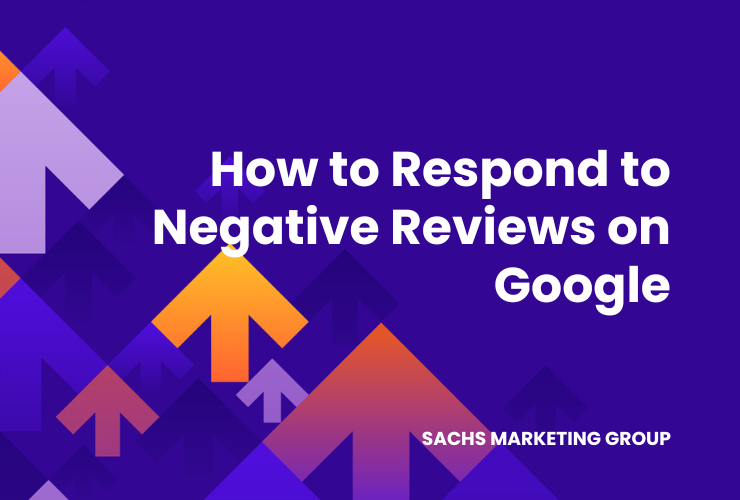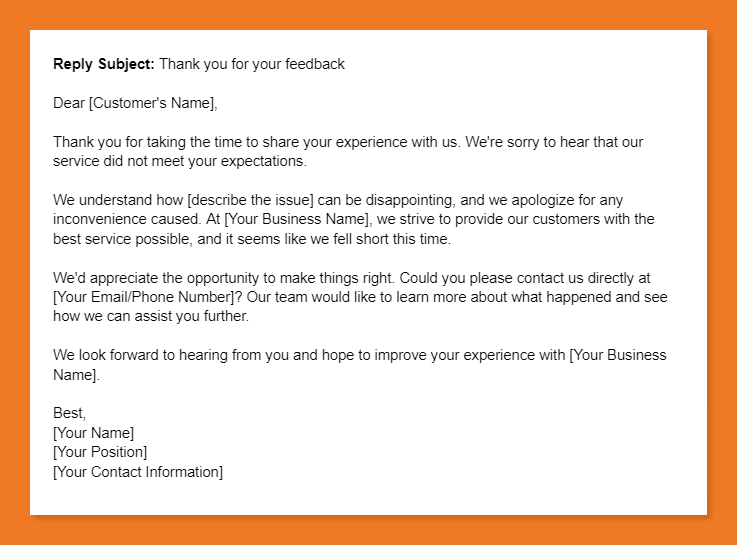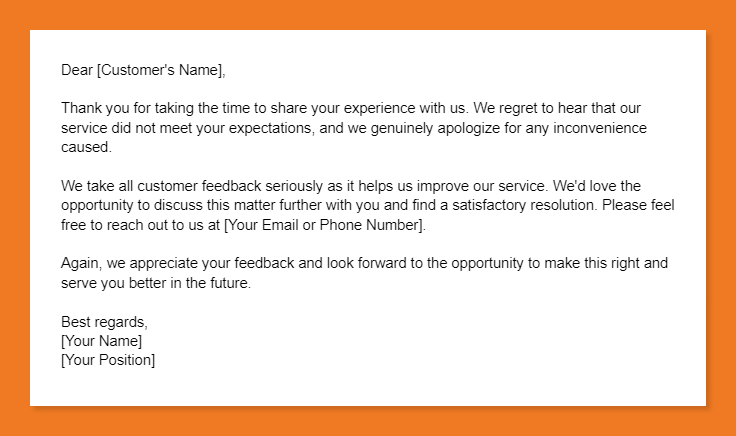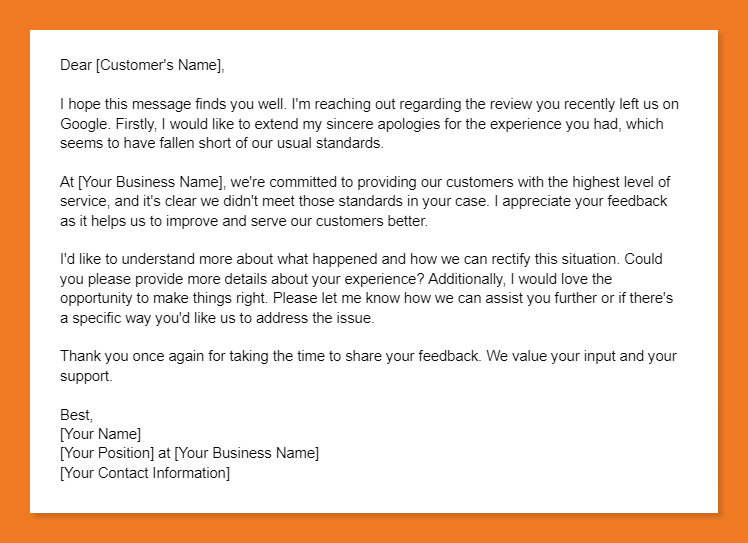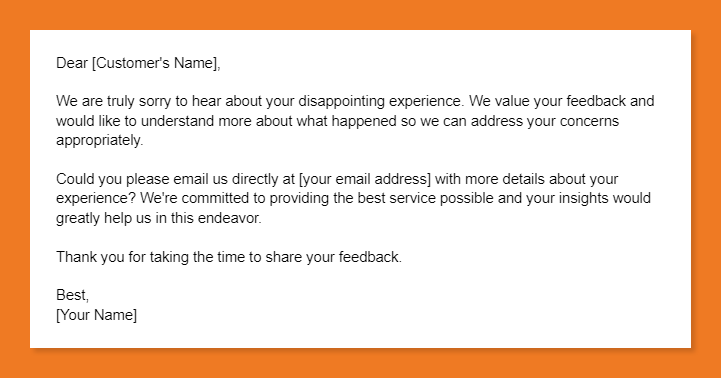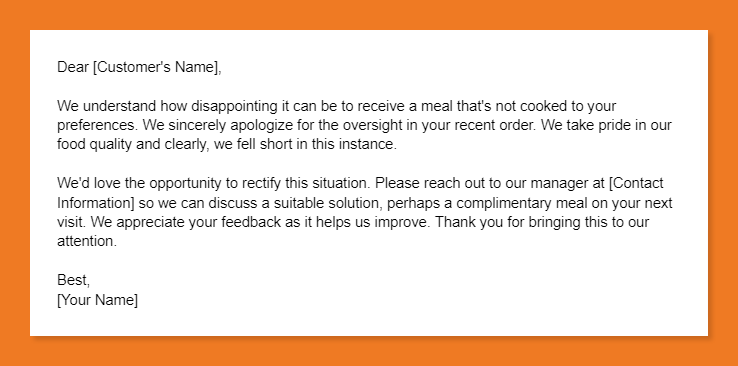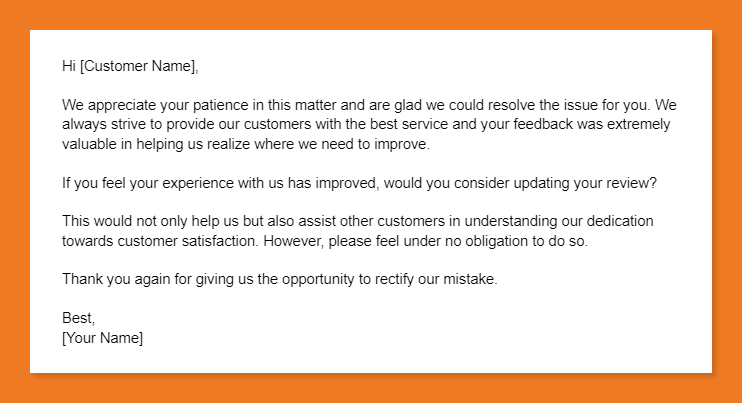Responding to negative reviews on Google requires a strategic and empathetic approach. Start by acknowledging the reviewer’s concerns and apologizing if necessary. Then, provide an explanation or solution if possible. Try to take the conversation offline for detailed discussions. Remember, your responses aren’t just for the reviewer, they’re for everyone who reads them. Demonstrating professionalism can turn a negative into a positive.
Negative reviews can significantly harm your business’s online reputation, directly affecting sales and customer trust. Many business owners feel vulnerable and unsure about how to handle these public criticisms on platforms like Google.
It’s important to remember that everyone is watching how you handle feedback. A poorly handled response can exacerbate the problem, leading to more distrust and potential customers being driven away.
The good news is, with the right approach, you can turn these situations into opportunities for growth. A well-crafted, professional response can not only win back a dissatisfied customer but can also show prospective customers that you value their feedback and are committed to improving.
Overview
Why Negative Reviews Matter
It’s a known fact that positive reviews can help fix your online reputation and customer trust, but why are negative reviews so important?
Negative reviews provide critical feedback that can help you improve your business operations and customer service. They also add an element of authenticity to your review profile. Consumers are smart – they know no business is perfect, and a mix of positive and negative reviews appears more genuine.
A well-handled negative review can potentially convert an unsatisfied customer into a brand advocate.
So, how should you respond to negative reviews on Google?
Let’s take a closer look at some of the best ways to respond to negative Google reviews with tips and examples.
How to Respond to Negative Reviews on Google
Google reviews are a critical element of your reputation online, and as such, they’re an integral part of your online marketing strategy.
Today, customers often check reviews and ratings on Google before deciding whether to patronize a business. Therefore, dealing with negative reviews effectively is crucial.
You might view these reviews as a black mark, a blemish to quickly remove or ignore. But it’s essential to realize that negative reviews can be an opportunity to demonstrate the high level of your customer service, showcase your brand’s personality, and even rectify a situation gone wrong.
1. Stay calm and evaluate the feedback internally
Staying calm when confronted with negative reviews is essential. Negative comments can evoke a strong emotional response, but it’s vital to separate personal feelings from business when handling such situations. Reacting defensively or aggressively can damage your business’s reputation further. Instead, view negative reviews as constructive feedback, providing valuable insight into areas where your business can improve.
When a negative review comes in, don’t respond immediately. Allow yourself time to absorb the feedback and regain emotional equilibrium. This will ensure that your response is professional, tactful, and beneficial to both your business and the customer.
Evaluating the feedback internally is equally important. Share the review with your team, discuss what might have led to the customer’s experience, and brainstorm potential improvements. Remember, the goal is not to assign blame but to understand the problem and prevent similar issues in the future.
2. Use a review response template
While each response to a negative review should be personalized to the customer’s specific situation, using a review response template can provide a solid foundation for your message. These templates guide you in structuring your responses effectively and consistently. They help maintain a consistent tone, which is crucial for upholding your brand image.
However, remember that each complaint is unique, and so should be your response. Use the template as a starting point, but ensure that your reply is personalized and addresses the specific issues raised by the customer. This demonstrates to both the reviewer and other potential customers that you take feedback seriously and are committed to individual customer satisfaction.
If you want to save time, consider putting together several review response templates to help you handle feedback faster. If you work with a reputation management company, work together to create responses for the most common types of feedback you receive, including everything from 1-star reviews, 5-star reviews, and star ratings with no comments.
Here’s an example of a review response template:
Remember, this template should be adapted to fit the nature of the complaint and your brand voice. The more personalized and sincere the response, the better the outcome is likely to be.
3. Publicly respond to the review
It’s essential to respond to negative reviews publicly for two reasons. First, it gives you a chance to turn an unhappy customer into a satisfied one. Second, it allows potential customers to see your business’s commitment to resolving issues and improving the customer experience. However, it’s important to respond in a way that is respectful, empathetic, and professional.
Here are some simple guidelines you can follow:
- Thank the customer for their feedback: Express your gratitude for the customer’s time to write the review. It shows that you value their opinion and take their feedback seriously.
- Acknowledge the issue: Demonstrate empathy and understanding for the customer’s dissatisfaction. Even if you believe your business is not at fault, understand that the customer’s perception is their reality.
- Offer a solution: If appropriate, propose a solution to the problem. This could be an invitation to discuss the matter further offline, an offer of a refund, or a promise to rectify the situation.
- Wrap up positively: End your response on a positive note. Thank the customer again for their feedback and express your hope to serve them better in the future.
Here’s an example of how to respond to a negative review publicly:
This example showcases professionalism and empathy, offers a potential solution, and ends on a positive note, thus reflecting positively on the business.
4. Reach out to the reviewer privately
While public responses are necessary to show prospective customers your dedication to addressing concerns, it’s equally crucial to reach out to the reviewer privately when possible. This private outreach allows for a more personal and in-depth conversation without airing all the details in public view. In these conversations, you can ask more detailed questions about their experience, apologize sincerely, and offer remedies tailored to their particular situation.
Keep in mind, your tone should remain professional and understanding, just as in your public responses. This direct outreach can make the customer feel valued and heard, and it provides a space for them to air any further grievances. In turn, it provides you with valuable insights into areas of improvement.
Here’s what a private response might look like:
Remember, the primary goal of reaching out privately is to make things right for the customer and gather more insights to prevent such incidents in the future. The idea is not to persuade them to remove or change their review, although that might happen naturally if the situation is resolved to their satisfaction.
5. Be transparent about mistakes
Transparency is a key factor in successful business operations, especially when it comes to dealing with negative reviews. Consumers appreciate honesty, and being upfront about mistakes can actually help build trust and credibility.
[smgquote author=”Eric Sachs, CEO”]
Make it honest, transparent, and genuine, and speak like you were speaking to a colleague or friend.
[/smgquote]
Here’s how you can practice transparency when dealing with mistakes:
- Acknowledge the Issue: The first step in being transparent is to acknowledge the mistake. Trying to deny or ignore it can lead to further dissatisfaction and mistrust among your customers.
- Communicate Openly: Use clear, concise language to explain what went wrong. Avoid using jargon or overly technical terms which can make it seem like you’re trying to obscure the issue.
- Apologize Sincerely: A sincere apology can go a long way in repairing the relationship with your customer. It shows that you take their concerns seriously and are regretful for any inconvenience caused.
- Offer a Solution: Explain how you plan to rectify the mistake. This could be a replacement, refund, or other form of compensation, depending on the situation.
- Implement Changes: If the mistake highlights a flaw in your operations, implement necessary changes to prevent it from happening again. This shows that you are proactive and committed to improving.
- Update Your Customers: Keep the affected customer(s) updated on the steps you are taking to address the issue. This demonstrates that you value their feedback and are dedicated to resolving their concerns.
- Share Lessons Learned: Let your customers know what you’ve learned from the situation. This not only showcases your commitment to growth but also makes it clear that you see negative feedback as an opportunity to improve.
By being transparent about your mistakes, you show that you value your customers and their feedback. It also signals to potential customers that you are a business that can be trusted, and that you’re committed to delivering the best possible service.
6. Seek clarification and more details
Sometimes, a negative review might be vague or lack enough details for you to address the issue correctly. In these cases, it’s crucial to seek further information to truly understand the customer’s experience and dissatisfaction. However, asking for clarification should be done privately to ensure the customer doesn’t feel interrogated or attacked publicly.
To do this, you can encourage the customer to get in touch with you privately, such as via direct message or email. It is important to communicate in your response that you take their concerns seriously and are keen to understand more so that you can resolve the issue effectively.
Here’s an example of how you can respond:
This approach not only protects the customer’s privacy but also underscores your commitment to resolving their issue effectively. Remember, the goal is to turn the negative situation into a positive one and demonstrate to all who see the review that your business values its customers and their feedback.
7. Empathize and offer solutions
One of the key steps in responding to negative reviews is to empathize with the customer’s experience and offer solutions. Empathy communicates that you understand their frustration and value their feedback, which can significantly contribute to defusing the situation.
Start your response by acknowledging the problem. Use phrases like, “We understand…” or “We can see how…” to show that you are taking their concerns seriously. Following this, apologize sincerely, without making excuses. A simple, “We’re truly sorry…” can go a long way in demonstrating your business’s humility and commitment to customer satisfaction.
Following your acknowledgement and apology, you should offer a solution or rectify the situation. This could be in the form of a refund, a replacement, or a promise to address the issue so it won’t happen in the future. By providing a solution, you’re demonstrating that your business values its customers and their satisfaction above all.
Here’s how a restaurant owner might respond to a review about an overcooked steak:
In this example, the business owner acknowledges the problem, empathizes with the customer’s poor dining experience, offers an apology, and then provides a solution. Not only does this respond directly to the unhappy customer, but it also shows other potential customers that this business cares about customer satisfaction and is willing to go the extra mile to ensure it.
8. Provide an incentive if necessary
There are times when simply apologizing and addressing the issue may not be enough. In such cases, it might be helpful to offer an incentive to the dissatisfied customer. This not only shows your dedication to resolving the issue but also goes a long way towards rebuilding trust. The incentive should be appropriate and proportional to the problem.
Remember, the intention of providing an incentive is not to ‘buy’ a positive review. Instead, it’s to rectify the situation and reiterate your commitment to exceptional customer service.
Here are a few incentive ideas that you can consider:
- Discounts on Future Purchases: This can be a specific percentage off their next purchase or a flat amount, depending on your business model.
- Free Products or Services: This could be a free sample of a new product or a complimentary service.
- Refund or Credit: If the problem was severe, you might want to consider offering a refund or credit towards future purchases.
- Exclusive Access: Offer them early or exclusive access to a new product, service, or event.
- Loyalty Points: If you have a loyalty program, you could offer them additional points.
- Personalized Gifts: Depending on the nature of your business, you might also consider a personalized gift or gesture, which shows a high level of care and attention.
Remember, the key to providing an effective incentive is to tailor it to the customer’s interests and the nature of your business. The incentive should be seen as a genuine attempt to make amends and not as a way to ‘bribe’ the customer into changing their review.
9. Sign your name at the end of your response
Including your name at the end of your public response adds a personal touch to the message, showing there’s a real person behind the business who genuinely cares about the customer’s experience. It humanizes your brand and makes the communication more personal, which can help to soften the negative impact of the review.
Signing your name also adds a level of accountability. It demonstrates that you, as a representative of the business, take ownership of the situation and are committed to resolving any issues. This can be particularly beneficial in situations where customers feel unheard or unappreciated, as it reassures them that their concerns are being taken seriously.
Signing your name at the end of a public response is a simple yet effective practice that can enhance your business’s credibility, foster better customer relationships, and ultimately, contribute to a more positive perception of your business.
10. Request an update for the review
After you’ve handled a customer’s complaint effectively, it’s entirely appropriate to ask the customer to reconsider their initial negative review. It’s crucial, though, to approach this with delicacy and respect, understanding that the customer is under no obligation to update their review.
When asking a customer to update their review, you should ensure that the customer’s issue has been fully resolved, and they are genuinely satisfied with the steps you’ve taken. Be sincere and explain that their feedback is valuable and that an updated review can help future customers to make informed decisions.
Ensure you don’t sound desperate or aggressive in your request, and never offer incentives for customers to change their reviews, as this can come off as dishonest and can violate the policies of many review platforms, including Google.
By acknowledging their frustration, making an effort to resolve the issue, and politely requesting an update, you can potentially turn a negative experience into a positive one, which will be visible to everyone who reads your reviews.
11. Hire a professional
For many businesses, managing online reputation, particularly responding to negative reviews, can feel overwhelming.
This is where a professional reputation management service can come into play. They possess the expertise and resources needed to handle your online presence effectively and professionally. Here are some key benefits of hiring a professional for reputation management:
- Expert Handling: Professionals understand the nuances of responding to both positive and negative reviews, ensuring your responses are well-crafted, courteous, and professional. They know how to de-escalate situations and transform negative experiences into opportunities for growth.
- Time Efficiency: Reputation management can be time-consuming. By hiring a professional, you can free up your time to focus on other important aspects of your business.
- Consistent Monitoring: Reputation management services offer consistent monitoring of your online reviews and promptly alert you to any issues that need immediate attention.
- Proactive Reputation Building: They don’t just manage reviews; they also help build a strong and positive online presence for your business. This includes promoting positive content and reviews to enhance your brand’s image.
- Strategic Planning: Professionals can help you devise a solid reputation management strategy tailored to your specific business needs, helping you stay ahead of potential issues.
- SEO Benefits: Good reputation management also includes optimizing your business profiles for search engines. This can lead to better visibility online and attract more potential customers.
- Analytics and Reporting: Professionals provide you with detailed reports and insights into your online reputation, including customer sentiment analysis and trends, enabling you to make informed decisions about your business.
Remember, your online reputation is an extension of your customer service. By investing in a reputable reputation management, you can ensure that your business is seen in the best light possible, leading to increased trust, customer loyalty, and business growth.
How to Respond to Different Star Reviews
Responding to reviews of varying star ratings requires different approaches. The key is to always maintain professionalism, show appreciation for feedback, and demonstrate your commitment to improving the customer experience.
How to Respond to a 1-Star Review on Google
Responding to 1-star reviews can be challenging. However, they present an opportunity to show potential customers your commitment to rectifying issues and providing excellent customer service. Start by thanking the reviewer for their feedback, apologize sincerely for their poor experience, and address their specific concerns. Offer a solution if possible, or invite them to contact you directly so you can resolve the issue. It’s important to remain calm, professional, and respectful in your response.
How to Respond to a 2-Star Review on Google
With 2-star reviews, the customer likely had a mixed experience. Acknowledge their concerns, express your gratitude for their feedback, and apologize for any dissatisfaction. Provide any necessary context or clarification without sounding defensive. Offer to further discuss and rectify the situation privately, demonstrating your commitment to improving their experience.
How to Respond to a 3-Star Review on Google
3-star reviews often indicate a satisfactory but not outstanding experience. Thank the reviewer for their feedback and discuss any issues they might have raised. This shows you value all feedback, not just the positive. Use their critique as a stepping stone for improving your service or product.
How to Respond to a 4-Star Review on Google
4-star reviews are generally positive but indicate there’s room for improvement. Thank the customer for their feedback and their positive comments. For any issues raised, acknowledge them, apologize if necessary, and assure the customer that their feedback will be used to improve future experiences.
How to Respond to a 5-Star Review on Google
For 5-star reviews, be sure to express your gratitude. These customers are advocates for your business, so make them feel valued. Thank them for taking the time to leave a review, and let them know you’re pleased they had a great experience. You might also encourage them to spread the word among their friends or return to your business in the future.
Remember, responding to reviews, positive or negative, shows you value your customers’ opinions and are committed to improving their experiences.
Negative Review FAQs
We’ve helped respond to thousands of negative reviews over the years, so we thought we’d share some of the more frequently asked questions we hear from business owners interested in learning how to respond.
How do I respond to a negative Google review without comments?
Responding to a negative Google review without comments can be tricky but not impossible. Acknowledge the reviewer and express your regret over their negative experience, even though they haven’t provided specific details. Encourage them to get in touch directly with you, so you can understand their issues better and work to resolve them, enhancing their customer experience.
What can you do if you get a bad review on Google?
If you get a bad review on Google, the best approach is to respond promptly, honestly, and professionally. Apologize for any shortcomings and ask for specifics of their experience, offering a solution if applicable. This shows you value customer feedback and are committed to improving, which can often turn a negative into a positive experience.
Is it worth responding to Google reviews?
Yes, it’s definitely worth responding to Google reviews. Responding to reviews, both positive and negative, shows that you value your customers and their feedback. Furthermore, it can help improve your business’s reputation, enhance customer loyalty, and even boost your ranking in search results as Google considers responsiveness in its algorithm.
How do I respond to negative feedback on Google review?
Responding to negative feedback on Google reviews requires tact and professionalism. Acknowledge the reviewer’s experience, apologize sincerely, and address the specific issues mentioned. Propose a solution or invite the customer to discuss the matter further offline. This shows other readers that you value customer feedback and are committed to improving their experiences.
Need Help Responding to Negative Reviews?
Are negative Google reviews tarnishing your business image?
With Sachs Marketing Group’s reputation management services, you can turn this around. We specialize in managing and improving your online reputation, ensuring each review receives a professional response that highlights your commitment to customer satisfaction.
Picture your business earning the trust of potential customers because they see how well you handle criticism and complaints. You’d not only be managing your reputation but also attracting more loyal customers.
Don’t let negative reviews hold your business back. Reach out to Sachs Marketing Group today to set up a time to meet Eric Sachs and learn how our team can help your business protect and grow its online reputation.
Conclusion
Handling negative reviews on Google is a critical aspect of your online reputation management. Responding to each review—be it 1-star or 5-star—with professionalism and empathy can turn dissatisfied customers into advocates, and also impress potential customers.
Don’t allow negative feedback to dampen your business image. Instead, use them as an opportunity to showcase your commitment to customer satisfaction and continuous improvement.
If managing this process seems daunting, consider partnering with experts like Sachs Marketing Group to help you turn your online reputation into a powerful business asset. Remember, the aim is not to avoid negative reviews, but to handle them in a way that adds value to your business.
Contact us today to get the conversation started!

